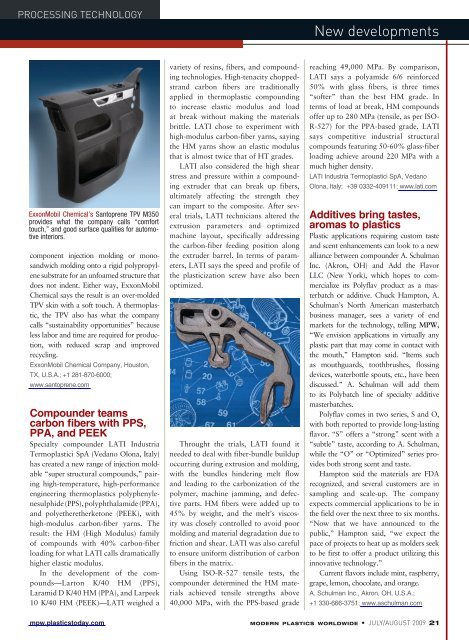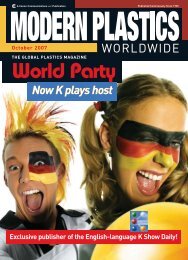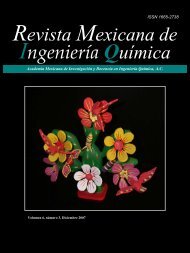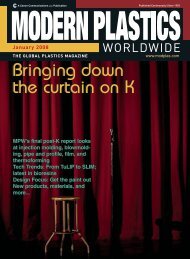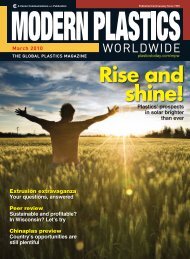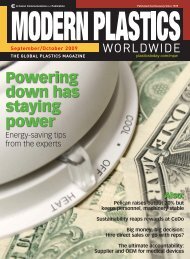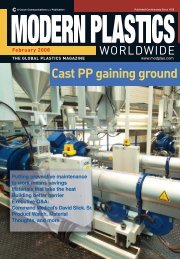Modern Plastics Worldwide - July/August 2009 - dae uptlax
Modern Plastics Worldwide - July/August 2009 - dae uptlax
Modern Plastics Worldwide - July/August 2009 - dae uptlax
Create successful ePaper yourself
Turn your PDF publications into a flip-book with our unique Google optimized e-Paper software.
PROCESSING TECHNOLOGY<br />
ExxonMobil Chemical’s Santoprene TPV M350<br />
provides what the company calls “comfort<br />
touch,” and good surface qualities for automotive<br />
interiors.<br />
component injection molding or monosandwich<br />
molding onto a rigid polypropylene<br />
substrate for an unfoamed structure that<br />
does not indent. Either way, ExxonMobil<br />
Chemical says the result is an over-molded<br />
TPV skin with a soft touch. A thermoplastic,<br />
the TPV also has what the company<br />
calls “sustainability opportunities” because<br />
less labor and time are required for production,<br />
with reduced scrap and improved<br />
recycling.<br />
ExxonMobil Chemical Company, Houston,<br />
TX, U.S.A.; +1 281-870-6000;<br />
www.santoprene.com<br />
Compounder teams<br />
carbon fi bers with PPS,<br />
PPA, and PEEK<br />
Specialty compounder LATI Industria<br />
Termoplastici SpA (Vedano Olona, Italy)<br />
has created a new range of injection moldable<br />
“super structural compounds,” pairing<br />
high-temperature, high-performance<br />
engineering thermoplastics polyphenylenesulphide<br />
(PPS), polyphthalamide (PPA),<br />
and polyetheretherketone (PEEK), with<br />
high-modulus carbon-fiber yarns. The<br />
result: the HM (High Modulus) family<br />
of compounds with 40% carbon-fiber<br />
loading for what LATI calls dramatically<br />
higher elastic modulus.<br />
In the development of the compounds—Larton<br />
K/40 HM (PPS),<br />
Laramid D K/40 HM (PPA), and Larpeek<br />
10 K/40 HM (PEEK)—LATI weighed a<br />
mpw.plasticstoday.com<br />
variety of resins, fibers, and compounding<br />
technologies. High-tenacity choppedstrand<br />
carbon fibers are traditionally<br />
applied in thermoplastic compounding<br />
to increase elastic modulus and load<br />
at break without making the materials<br />
brittle. LATI chose to experiment with<br />
high-modulus carbon-fiber yarns, saying<br />
the HM yarns show an elastic modulus<br />
that is almost twice that of HT grades.<br />
LATI also considered the high shear<br />
stress and pressure within a compounding<br />
extruder that can break up fibers,<br />
ultimately affecting the strength they<br />
can impart to the composite. After several<br />
trials, LATI technicians altered the<br />
extrusion parameters and optimized<br />
machine layout, specifically addressing<br />
the carbon-fiber feeding position along<br />
the extruder barrel. In terms of parameters,<br />
LATI says the speed and profile of<br />
the plasticization screw have also been<br />
optimized.<br />
Throught the trials, LATI found it<br />
needed to deal with fiber-bundle buildup<br />
occurring during extrusion and molding,<br />
with the bundles hindering melt flow<br />
and leading to the carbonization of the<br />
polymer, machine jamming, and defective<br />
parts. HM fibers were added up to<br />
45% by weight, and the melt’s viscosity<br />
was closely controlled to avoid poor<br />
molding and material degradation due to<br />
friction and shear. LATI was also careful<br />
to ensure uniform distribution of carbon<br />
fibers in the matrix.<br />
Using ISO-R-527 tensile tests, the<br />
compounder determined the HM materials<br />
achieved tensile strengths above<br />
40,000 MPa, with the PPS-based grade<br />
New developments<br />
reaching 49,000 MPa. By comparison,<br />
LATI says a polyamide 6/6 reinforced<br />
50% with glass fibers, is three times<br />
“softer” than the best HM grade. In<br />
terms of load at break, HM compounds<br />
offer up to 280 MPa (tensile, as per ISO-<br />
R-527) for the PPA-based grade. LATI<br />
says competitive industrial structural<br />
compounds featuring 50-60% glass-fiber<br />
loading achieve around 220 MPa with a<br />
much higher density.<br />
LATI Industria Termoplastici SpA, Vedano<br />
Olona, Italy; +39 0332-409111; www.lati.com<br />
Additives bring tastes,<br />
aromas to plastics<br />
Plastic applications requiring custom taste<br />
and scent enhancements can look to a new<br />
alliance between compounder A. Schulman<br />
Inc. (Akron, OH) and Add the Flavor<br />
LLC (New York), which hopes to commercialize<br />
its Polyflav product as a masterbatch<br />
or additive. Chuck Hampton, A.<br />
Schulman’s North American masterbatch<br />
business manager, sees a variety of end<br />
markets for the technology, telling MPW,<br />
“We envision applications in virtually any<br />
plastic part that may come in contact with<br />
the mouth,” Hampton said. “Items such<br />
as mouthguards, toothbrushes, flossing<br />
devices, waterbottle spouts, etc., have been<br />
discussed.” A. Schulman will add them<br />
to its Polybatch line of specialty additive<br />
masterbatches.<br />
Polyflav comes in two series, S and O,<br />
with both reported to provide long-lasting<br />
flavor. “S” offers a “strong” scent with a<br />
“subtle” taste, according to A. Schulman,<br />
while the “O” or “Optimized” series provides<br />
both strong scent and taste.<br />
Hampton said the materials are FDA<br />
recognized, and several customers are in<br />
sampling and scale-up. The company<br />
expects commercial applications to be in<br />
the field over the next three to six months.<br />
“Now that we have announced to the<br />
public,” Hampton said, “we expect the<br />
pace of projects to heat up as molders seek<br />
to be first to offer a product utilizing this<br />
innovative technology.”<br />
Current flavors include mint, raspberry,<br />
grape, lemon, chocolate, and orange.<br />
A. Schulman Inc., Akron, OH, U.S.A.;<br />
+1 330-666-3751; www.aschulman.com<br />
MODERN PLASTICS WORLDWIDE • JULY/AUGUST <strong>2009</strong> 21


